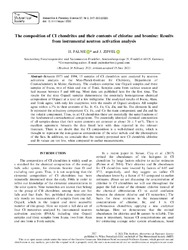The composition of CI chondrites and their contents of chlorine and bromine: Results from instrumental neutron activation analysis
Persistent URL: http://resolver.sub.uni-goettingen.de/purl?gldocs-11858/11065
 |
Dokument öffnen: |
Between 1973 and 1994, 15 samples of CI chondrites were analyzed by neutron activation analysis at the Max‐Planck‐Institute for Chemistry, Department of Cosmochemistry in Mainz, Germany. The analyses comprise nine Orgueil samples and three samples of Ivuna, two of Alais and one of Tonk. Samples came from various sources and had masses between 5 and 600 mg. Most data are published here for the first time. The results for the nine Orgueil samples demonstrate the essentially homogeneous chemical composition of Orgueil at a level of a few milligrams. The analytical results of Ivuna, Alais, and Tonk agree, with only few exceptions, with the results of Orgueil analyses. All samples agree within ±3% in their contents of Sc, Ir, Cr, Fe, Co, Zn, and Se. The elements Sc and Ir represent the refractory component; Cr, Fe, and Co the main component; and Zn and Se the volatile component. Thus, in all CI chondrites there are essentially the same fractions of the fundamental cosmochemical components. The essentially identical chemical composition of all samples shows that their water contents are constant at about 20 ± 5 wt%. There is excellent agreement between the data listed here with data reported in the relevant literature. There is no doubt that the CI composition is a well‐defined entity, which is thought to represent the non‐gaseous compositions of the solar nebula and the photosphere of the Sun. In addition, we conclude that the recently proposed new CI chondritic chlorine and Br values are too low, when compared to earlier measurements.

